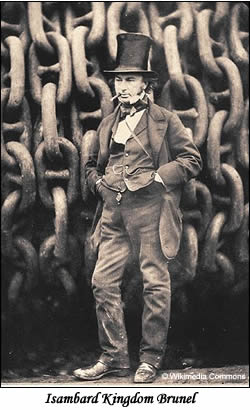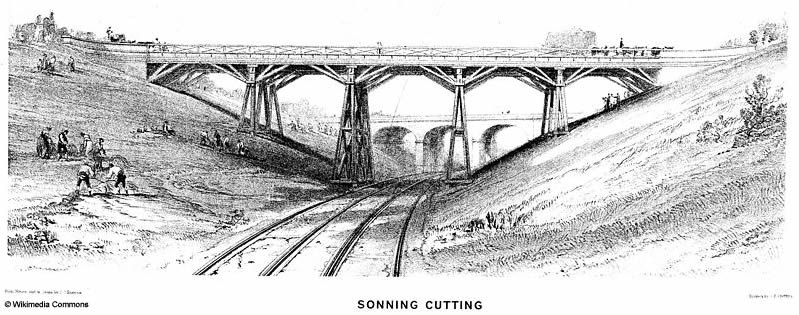The Great Western Railway (GWR) or, as it was more affectionately known, ‘God’s Wonderful Railway’ was one of the early railway companies and was established in 1833.
When Liverpool was connected to London by the railways, Bristol merchants felt their livelihoods threatened without a connection of their own, as they feared that trade would go to the port of Liverpool instead. The company was founded at a public meeting in Bristol in 1833, and two years later it was incorporated by an act of parliament.

Isambard Kingdom Brunel was appointed as the company’s engineer. He was the son of engineer Sir Marc Isambard Brunel and his wife Sophia (nee Kingdom), and was born in Portsmouth on 9th April 1806. His first major project was working alongside his father on the ‘Thames Tunnel’ at Wapping in London in the late 1820s/early1830s. This was the first tunnel to be successfully dug beneath a river, although several workers died in its construction, with Isambard narrowly escaping death on one such occasion.
The construction of the Great Western Railway was one of his major accomplishments, and he personally surveyed the proposed route all the way from London to Bristol. He envisaged a transport system whereby a passenger could purchase a ticket at the company’s station in London, which would take them all the way to New York, via ‘The Great Eastern’ steamship from the terminus of the line in Neyland, South Wales.
It was an ambitious plan which involved the construction of tunnels, viaducts, bridges, cuttings and embankments, and was to be the longest railway line in the world at the time. He did however make the controversial decision to use broad gauge for the track, when other railway companies were using Stephenson’s ‘standard gauge’. It took over 30 years after his death in 1859 for the whole of the GWR’s lines to be converted to the standard gauge.
The first section of the line to be opened on 4th June 1838 was from the temporary station buildings at Paddington to Maidenhead Bridge Station, which was located a short distance from the wide expanse of the River Thames – a natural obstacle which Brunel had to conquer.
He did this successfully, and a bridge consisting of two brick arches, each with a span of 128 feet, was opened later that same year. These were the widest and flattest arches in the world and even the directors on the board of GWR doubted whether it would take the weight of the trains. However, it still stands to this day.
Two years later the section of line was completed between Bristol and Bath, whilst the eastern section was extending west through the Sonning Cutting towards Reading, Swindon and Chippenham. The Box Tunnel which was dug through Box Hill linking Bath with Chippenham was opened in 1841. It was the longest railway tunnel in the world at the time and another of Brunel’s great engineering achievements, although 100 navvies were killed in its construction.
Brunel also designed GWR’s terminus at Paddington, with the station opening in 1854. His vision of a railway running between Paddington and South Wales was finally achieved in 1856 with passengers reaching Neyland, via his bridge at Chepstow. He died just 3 years later at the age of 53.

Christine in Herts’ great grandfather, William Charles Lancaster, worked as a porter, a signalman and then a guard on GWR’s line out of Paddington and through Berkshire. You can read his story, The Railwayman, in this issue.
Twenty years after Brunel’s death GWR was building the Severn Railway Tunnel, beneath the estuary of the River Severn, to create a more direct route into Wales, and this was completed in 1885. Merry Monty Montgomery’s great grandfather, Samuel Charles Burchill, is reputed to have driven the very first goods train through the tunnel on 9th January 1886. You can read his story, Lure of the Steam, in this issue.
The late 19th and early 20th centuries saw the company extending southwards into Devon and Cornwall, and northwards in Wales, furthering its links with smaller regional railway companies, whilst building new lines creating more direct routes. It also operated road motor services in more rural areas, with links to mainline stations.
After government control during World War One, GWR was one of the ‘Big Four’ railway companies created by the Railways Act of 1921, and was absorbed into ‘British Railways’ upon nationalisation in 1946.
Velma Dinkley
© Velma Dinkley 2009
Sources and Further Reading
The Great Western Archive
GWR road vehicles
Museum of the Great Western Railway
Brunel 200: Great Western Railway